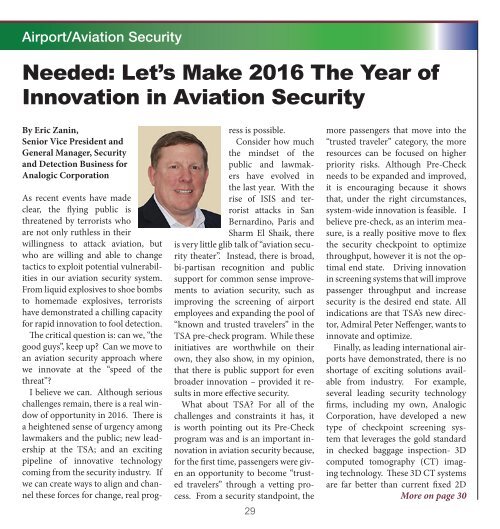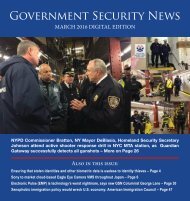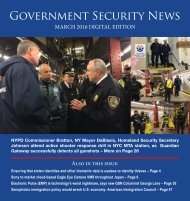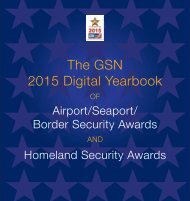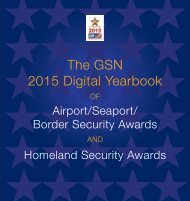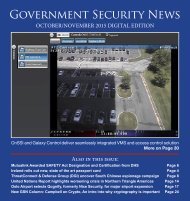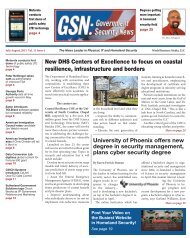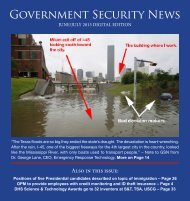GSN January 2016 Digital Edition
Create successful ePaper yourself
Turn your PDF publications into a flip-book with our unique Google optimized e-Paper software.
Airport/Aviation Security<br />
Needed: Let’s Make <strong>2016</strong> The Year of<br />
Innovation in Aviation Security<br />
By Eric Zanin,<br />
Senior Vice President and<br />
General Manager, Security<br />
and Detection Business for<br />
Analogic Corporation<br />
As recent events have made<br />
clear, the flying public is<br />
threatened by terrorists who<br />
are not only ruthless in their<br />
willingness to attack aviation, but<br />
who are willing and able to change<br />
tactics to exploit potential vulnerabilities<br />
in our aviation security system.<br />
From liquid explosives to shoe bombs<br />
to homemade explosives, terrorists<br />
have demonstrated a chilling capacity<br />
for rapid innovation to fool detection.<br />
The critical question is: can we, “the<br />
good guys”, keep up? Can we move to<br />
an aviation security approach where<br />
we innovate at the “speed of the<br />
threat”?<br />
I believe we can. Although serious<br />
challenges remain, there is a real window<br />
of opportunity in <strong>2016</strong>. There is<br />
a heightened sense of urgency among<br />
lawmakers and the public; new leadership<br />
at the TSA; and an exciting<br />
pipeline of innovative technology<br />
coming from the security industry. If<br />
we can create ways to align and channel<br />
these forces for change, real progress<br />
is possible.<br />
Consider how much<br />
the mindset of the<br />
public and lawmakers<br />
have evolved in<br />
the last year. With the<br />
rise of ISIS and terrorist<br />
attacks in San<br />
Bernardino, Paris and<br />
Sharm El Shaik, there<br />
is very little glib talk of “aviation security<br />
theater”. Instead, there is broad,<br />
bi-partisan recognition and public<br />
support for common sense improvements<br />
to aviation security, such as<br />
improving the screening of airport<br />
employees and expanding the pool of<br />
“known and trusted travelers” in the<br />
TSA pre-check program. While these<br />
initiatives are worthwhile on their<br />
own, they also show, in my opinion,<br />
that there is public support for even<br />
broader innovation – provided it results<br />
in more effective security.<br />
What about TSA? For all of the<br />
challenges and constraints it has, it<br />
is worth pointing out its Pre-Check<br />
program was and is an important innovation<br />
in aviation security because,<br />
for the first time, passengers were given<br />
an opportunity to become “trusted<br />
travelers” through a vetting process.<br />
From a security standpoint, the<br />
29<br />
more passengers that move into the<br />
“trusted traveler” category, the more<br />
resources can be focused on higher<br />
priority risks. Although Pre-Check<br />
needs to be expanded and improved,<br />
it is encouraging because it shows<br />
that, under the right circumstances,<br />
system-wide innovation is feasible. I<br />
believe pre-check, as an interim measure,<br />
is a really positive move to flex<br />
the security checkpoint to optimize<br />
throughput, however it is not the optimal<br />
end state. Driving innovation<br />
in screening systems that will improve<br />
passenger throughput and increase<br />
security is the desired end state. All<br />
indications are that TSA’s new director,<br />
Admiral Peter Neffenger, wants to<br />
innovate and optimize.<br />
Finally, as leading international airports<br />
have demonstrated, there is no<br />
shortage of exciting solutions available<br />
from industry. For example,<br />
several leading security technology<br />
firms, including my own, Analogic<br />
Corporation, have developed a new<br />
type of checkpoint screening system<br />
that leverages the gold standard<br />
in checked baggage inspection- 3D<br />
computed tomography (CT) imaging<br />
technology. These 3D CT systems<br />
are far better than current fixed 2D<br />
More on page 30


